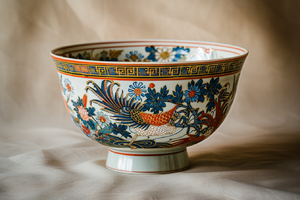Ko-Imari/te: Difference between revisions
Created page with "=== ముఖ్య లక్షణాలు ===" |
Created page with "కో-ఇమారి యొక్క విలక్షణమైన లక్షణాలు:" |
||
| Line 14: | Line 14: | ||
=== ముఖ్య లక్షణాలు === | === ముఖ్య లక్షణాలు === | ||
కో-ఇమారి యొక్క విలక్షణమైన లక్షణాలు: | |||
*బోల్డ్ మరియు రంగురంగుల డిజైన్లు, సాధారణంగా కోబాల్ట్ బ్లూ అండర్ గ్లేజ్ను ఎరుపు, ఆకుపచ్చ మరియు బంగారు రంగులలో ఓవర్ గ్లేజ్ ఎనామెల్స్తో కలుపుతాయి. | |||
* | *దాదాపు మొత్తం ఉపరితలాన్ని కప్పి ఉంచే దట్టమైన మరియు సుష్ట అలంకరణ, తరచుగా గొప్పగా అలంకరించబడిన లేదా సంపన్నమైనదిగా వర్ణించబడుతుంది. | ||
* | *క్రిసాన్తిమమ్స్, పియోనీలు, ఫీనిక్స్లు, డ్రాగన్లు మరియు శైలీకృత తరంగాలు లేదా మేఘాలు వంటి మోటిఫ్లు. | ||
* | *తరువాత, మరింత శుద్ధి చేసిన ముక్కలతో పోలిస్తే మందపాటి పింగాణీ శరీరం. | ||
* | |||
కో-ఇమారి సామాను కేవలం గృహ వినియోగం కోసం మాత్రమే ఉద్దేశించబడలేదు. అనేక ముక్కలు యూరోపియన్ అభిరుచులకు అనుగుణంగా రూపొందించబడ్డాయి, వీటిలో పెద్ద ప్లేట్లు, కుండీలు మరియు ప్రదర్శన కోసం అలంకరణలు ఉన్నాయి. | |||
< | <span id="Export_and_European_Reception"></span> | ||
== | == ఎగుమతి మరియు యూరోపియన్ ఆదరణ == | ||
<div lang="en" dir="ltr" class="mw-content-ltr"> | <div lang="en" dir="ltr" class="mw-content-ltr"> | ||
Revision as of 04:58, 18 July 2025
Ko-Imari

''కో-ఇమారి (అక్షరాలా ఓల్డ్ ఇమారి) అనేది 17వ శతాబ్దంలో ప్రధానంగా ఉత్పత్తి చేయబడిన జపనీస్ ఇమారి సామాను యొక్క తొలి మరియు అత్యంత ప్రసిద్ధ శైలిని సూచిస్తుంది. ఈ పింగాణీలు అరిటా పట్టణంలో తయారు చేయబడ్డాయి మరియు సమీపంలోని ఇమారి ఓడరేవు నుండి ఎగుమతి చేయబడ్డాయి, దీని కారణంగా ఈ సామాను దాని పేరును పొందింది. కో-ఇమారి ముఖ్యంగా దాని డైనమిక్ అలంకార శైలి మరియు ప్రారంభ ప్రపంచ పింగాణీ వ్యాపారంలో చారిత్రక ప్రాముఖ్యతకు ప్రసిద్ధి చెందింది.
చారిత్రక నేపథ్యం
1640ల ప్రాంతంలో అరిటా ప్రాంతంలో పింగాణీ బంకమట్టిని కనుగొన్న తర్వాత, ఎడో కాలం ప్రారంభంలో కో-ఇమారి సామాను ఉద్భవించింది. ప్రారంభంలో చైనీస్ నీలం-తెలుపు పింగాణీ ద్వారా ప్రభావితమైన స్థానిక జపనీస్ కుమ్మరులు వారి స్వంత శైలీకృత గుర్తింపును అభివృద్ధి చేసుకోవడం ప్రారంభించారు. మింగ్ రాజవంశం పతనం కారణంగా చైనా పింగాణీ ఎగుమతులు క్షీణించడంతో, జపనీస్ పింగాణీ అంతర్జాతీయ మార్కెట్లలో, ముఖ్యంగా డచ్ ఈస్ట్ ఇండియా కంపెనీతో వాణిజ్యం ద్వారా అంతరాన్ని పూరించడం ప్రారంభించింది.
ముఖ్య లక్షణాలు
కో-ఇమారి యొక్క విలక్షణమైన లక్షణాలు:
- బోల్డ్ మరియు రంగురంగుల డిజైన్లు, సాధారణంగా కోబాల్ట్ బ్లూ అండర్ గ్లేజ్ను ఎరుపు, ఆకుపచ్చ మరియు బంగారు రంగులలో ఓవర్ గ్లేజ్ ఎనామెల్స్తో కలుపుతాయి.
- దాదాపు మొత్తం ఉపరితలాన్ని కప్పి ఉంచే దట్టమైన మరియు సుష్ట అలంకరణ, తరచుగా గొప్పగా అలంకరించబడిన లేదా సంపన్నమైనదిగా వర్ణించబడుతుంది.
- క్రిసాన్తిమమ్స్, పియోనీలు, ఫీనిక్స్లు, డ్రాగన్లు మరియు శైలీకృత తరంగాలు లేదా మేఘాలు వంటి మోటిఫ్లు.
- తరువాత, మరింత శుద్ధి చేసిన ముక్కలతో పోలిస్తే మందపాటి పింగాణీ శరీరం.
కో-ఇమారి సామాను కేవలం గృహ వినియోగం కోసం మాత్రమే ఉద్దేశించబడలేదు. అనేక ముక్కలు యూరోపియన్ అభిరుచులకు అనుగుణంగా రూపొందించబడ్డాయి, వీటిలో పెద్ద ప్లేట్లు, కుండీలు మరియు ప్రదర్శన కోసం అలంకరణలు ఉన్నాయి.
ఎగుమతి మరియు యూరోపియన్ ఆదరణ
Ko-Imari ware was exported in large quantities throughout the 17th and early 18th centuries. It became a fashionable luxury item among European elites. In palaces and aristocratic homes across Europe, Ko-Imari porcelain adorned mantelpieces, cabinets, and tables. European porcelain manufacturers, particularly in Meissen and Chantilly, began producing their own versions inspired by Ko-Imari designs.
Evolution and Transition
By the early 18th century, the style of Imari ware began to evolve. Japanese potters developed more refined techniques, and new styles such as Nabeshima ware emerged, focusing on elegance and restraint. The term Ko-Imari is now used to specifically distinguish these early exported works from later domestic or revival pieces.
Legacy
Ko-Imari remains highly valued by collectors and museums worldwide. It is considered a symbol of Japan’s early contribution to global ceramics and a masterwork of Edo-period craftsmanship. The vivid designs and technical achievements of Ko-Imari continue to inspire both traditional and contemporary Japanese ceramic artists.
Relationship to Imari Ware
While all Ko-Imari ware is part of the broader category of Imari ware, not all Imari ware is considered Ko-Imari. The distinction lies primarily in the age, style, and purpose. Ko-Imari specifically refers to the earliest period, characterized by its dynamic energy, export orientation, and richly decorated surfaces.
